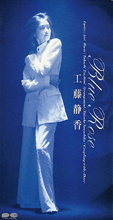Blue Rose (song)
"Blue Rose" is a song recorded by Japanese singer Shizuka Kudo, from her ninth studio album, Expose. It was released through Pony Canyon as the album's lead single on March 18, 1994. The song marks a significant change in artistic direction for Kudo, as it is her first single to be self-produced,[1] as well as her first release since parting ways with long-time collaborator Tsugutoshi Gotō, who has helmed Kudo's songwriting team since her solo debut.[2] It was featured on TV commercials for Seagaia Ocean Dome.[3] The single's B-side, "Door", is the ending theme to the TX television series Tsumiki Kuzushi: Hōkai, Soshite....[4] Kudo performed "Blue Rose" on the 45th Kōhaku Uta Gassen, marking her seventh consecutive appearance on the show.[5] It is the first in a trilogy of singles with the word "blue" in the title: "Blue Rose" was later followed by "Blue Velvet" and "Blue Zone".
| "Blue Rose" | ||||
|---|---|---|---|---|
 | ||||
| Single by Shizuka Kudo | ||||
| from the album Expose | ||||
| Released | March 18, 1994 | |||
| Genre | ||||
| Length | 4:40 | |||
| Label | Pony Canyon | |||
| Songwriter(s) |
| |||
| Producer(s) |
| |||
| Shizuka Kudo singles chronology | ||||
| ||||
| Audio sample | ||||
| ||||
Background
"Blue Rose" was written by Kudo, under the pseudonym Aeri, and Takashi Tsushimi.[2] It is the first single since "Senryū no Shizuku" to have Kudo credited as a lyricist. The song is written in the key of C# minor and set to a tempo of 112 beats per minute.[6] Kudo's vocals span from E3 to C♯5. Lyrically, Kudo incarnates a woman putting it all on the line to seduce a man. She likens her actions to that of a "sweet devil" when setting up a "diamond trap" for her lover, and declares herself a "blue angel" promising to find endless love. The song is noted for having a strong rock aesthetic.[7] It was praised for its copious hard guitar riffs, something out of the ordinary coming from Kudo, who received acclaim for unleashing her wild side on the record and amping up the style and glamour, both musically and visually.[7]
Live performances
Kudo's performances of "Blue Rose" are characterized by the accompanying intricate and sensual dance routine, performed alongside multiple backup dancers. The choreography was created by TRF's Sam and Chiharu. Kudo wore a different color variation of the same outfit when performing: a turtleneck crop top, high-slit maxi dress, over-the-knee stockings and platform heels. She wore an all-white version of the ensemble for her Kōhaku Uta Gassen performance. In a retrospective interview, Kudo named Janet Jackson as one of her inspirations for the performance style.[8] Japanese TV personality Mitz Mangrove has praised Kudo for the bold performances and cited her as one of the pioneers of Japanese dancing singers.[8]
Chart performance
The single debuted at number eight on the Oricon Singles Chart, selling 45,000 copies in its first week.[9] It spent a total of 16 weeks in the top 100; it fell off the charts in June, but charted for a week in January 1994, following Kudo's performance on Kōhaku, when it came back at number 97 before dropping off completely the next week. With over 299,000 copies sold in 1993, it came in at number 89 on the year-end Oricon Singles Chart.[10]
Track listing
All lyrics are written by Aeri; all music is composed by Takashi Tsushimi.
| No. | Title | Arranger(s) | Length |
|---|---|---|---|
| 1. | "Blue Rose" |
| 4:40 |
| 2. | "Door" |
| 4:45 |
| 3. | "Blue Rose" (Original Karaoke) |
| 4:40 |
| Total length: | 14:06 | ||
Charts
| Chart (1994) | Peak position |
|---|---|
| Japan Weekly Singles (Oricon)[11] | 8 |
| Japan Monthly Singles (Oricon)[12] | 12 |
| Japan Yearly Singles (Oricon)[10] | 89 |
Certification
| Region | Certification | Certified units/sales |
|---|---|---|
| Japan (RIAJ)[13] | Gold | 305,000[14] |
|
*sales figures based on certification alone | ||
References
- "【新堂本兄弟】#295 2007.05.20 23:15~ ゲストは工藤静香さん!". Fuji Television. Retrieved December 18, 2017.
- "工藤静香「Blue Rose」-『Expose』収録". Recochoku. Retrieved December 18, 2017.
- "Blue Rose 工藤静香, 愛絵理, 澤近泰輔, カラオケ". Amazon. Retrieved December 18, 2017.
- "Door 工藤静香 - 歌詞タイム". Kasi Time. Retrieved December 18, 2017.
- "NHK紅白歌合戦ヒストリー 第45回(1994年/平成6年)". NHK. Retrieved December 18, 2017.
- "Blue Rose 楽譜:メロディ譜 工藤 静香". @Elise. Retrieved December 18, 2017.
- "工藤静香 / ミレニアム・ベスト". CDJournal. Retrieved December 18, 2017.
- "工藤静香、ソロデビュー30周年トークイベントの模様をGYAO!でアーカイブ配信". OKMusic. September 1, 2017. Retrieved December 18, 2017.
- "1994年3月28日付 CDシングル/アルバムランキング". Archived from the original on 2016-06-02. Retrieved December 18, 2017.
- "オリコン 1994年TOP100". Retrieved December 18, 2017.
- "Blue Rose 工藤静香". Oricon. Retrieved December 18, 2017.
- "オリコン(oricon)「1994年04月」の月間シングルCDランキング". Retrieved January 18, 2018.
- ゴールドディスク認定 [Gold Disc Certifications] (in Japanese). Recording Industry Association of Japan. March 1994. Retrieved December 18, 2017.
Select 1994年3月 on the drop-down menu
- "工藤静香 - アーティスト別シングル売上補完". @wiki. Retrieved December 20, 2017.